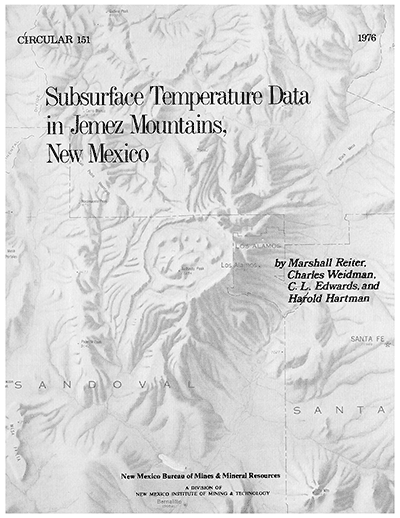
Circular 151—Subsurface temperature data in Jemez Mountains, New Mexico
By M. A. Reiter, C. Weidman, C. L. Edwards, and H. Hartman, 1976, 16 pp., 14 figs.

Presents subsurface temperature data for 13 drill tests in the Jemez Mountains. Subsurface temperature data are presented for 13 drill tests in the Jemez Mountains, a Tertiary and Quaternary volcanic field in north-central New Mexico associated with Valles Caldera. A geologic map of the Jemez Mountains has been prepared by Smith and others. Bailey and others and Doell and others presented data indicating volcanic activity may have begun in the Valles Caldera about 9 Ma B.P. Following a period of quiescence, catastrophic eruptions of ash flows resulted in the formation of the Valles Caldera. The intracaldera domes are dated from 0.4 Ma B.P. to 1 Ma B.P.
Summers described hot spring activity in the Jemez Mountains and related the thermal waters to the volcanism of the area. Jiracek summarized geophysical studies in the Jemez Mountains area. The immensity of the Valles Caldera and its geologic history suggest the probable geothermal potential of the area. Consequently, a series of tests were drilled around the Valles Caldera by the Los Alamos Scientific Laboratory; subsurface temperature measurements were made in these holes by the New Mexico Institute of Mining and Technology in a cooperative effort to study the heat-flow pattern in the Jemez Mountains. Subsurface temperature gradients were calculated from in situ, equilibrium measurements taken at progressively deeper depths in the drill tests. In situ temperature data were taken by using resistance thermometry; that is, platinum or thermistor sondes in conjunction with Mueller Bridge electronics for surface recording. At four locations estimates of the thermal conductivity of the rocks from the holes were obtained by measurements on core and fragment specimens. These conductivity measurements multiplied by the appropriate temperature gradients yield estimates of the heat-flow values at the appropriate drill sites.
Temperature data taken in 13 drill tests around the Valles Caldera, near
the boundary of the Baca Location No., 1 are presented. Seven of these tests
were shallow auger holes near the eastern, southern, and western boundaries,
four were rotary holes of intermediate depth along the western boundary,
and two were relatively deep tests. Of these last two, one was on the eastern
flank of the Jemez Mountains. The other hole, penetrating to a depth of
730 m at basement rock, is located west of the Valles Caldera. Heat-flow
measurements were obtained in the four intermediate drill tests whereas
only geothermal gradients were measured in the remaining tests. Potential
ground-water movement, lack of good thermal conductivity control, and the
shallow depth of many drill tests makes the heat-flow pattern in the area
uncertain. Two trends appear likely: higher heat flows are to the western
side of the Valles Caldera and heat flows increase rapidly in approaching
the margin of the Valles Caldera from the west. Both observations suggest
a relatively shallow heat source located beneath the western part of the
Valles Caldera.
$3.75
Buy
Now
Also available as a free download.
Download
| File Name | Size | Last Modified |
|---|---|---|
| Circular-151.pdf | 1.14 MB | 01/11/2021 02:59:26 PM |



